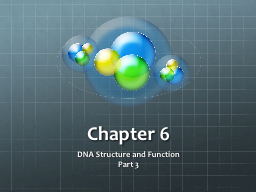

Function Part 3 Cloning Cloning means making an identical copy of something In biology it can refer to A lab method in which researchers copy fragments of DNA A reproductive method in which researchers produce an exact genetic copy of an entire organism ID: 1009373
Download Presentation The PPT/PDF document "Chapter 6 DNA Structure and" is the property of its rightful owner. Permission is granted to download and print the materials on this web site for personal, non-commercial use only, and to display it on your personal computer provided you do not modify the materials and that you retain all copyright notices contained in the materials. By downloading content from our website, you accept the terms of this agreement.
1. Chapter 6DNA Structure and Function Part 3
2. CloningCloning means making an identical copy of somethingIn biology it can refer toA lab method in which researchers copy fragments of DNAA reproductive method in which researchers produce an exact genetic copy of an entire organism.
3. CloningNature makes genetically identical organisms all the time by:Asexual reproductionThe splitting of an embryoArtificial twinning is reproductive cloning performed by researchers in a lab.In this process, a ball of cells is grown in a lab from a fertilized egg.This ball is then forced to separate into two identical halves, each of which then develops as a separate embryo.These embryos are then implanted into surrogate mothers, who give birth to identical twins.This technique is performed often in research laboratories with animals.
4. CloningSince nature’s clones, identical twins, get their DNA from two parents (who are genetically different from one another), even though they are identical to each other, they are not identical to either parent.On the other hand, if an animal breeder wants to produce an exact copy of a specific, adult organism, they perform adult cloning, another type of reproductive cloning.In adult cloning, the researcher begins with a single body cell taken from an adult organism.
5. CloningThe trick to adult cloning lies in the fact that, although all adult body cells contain the same DNA (for the most part), these cells have differentiated into certain cell types (such as a liver cell or muscle cell) due to the fact that they have begun using certain subsets of their DNA.This differentiation is a one-way path.Once a cell has specialized (or differentiated), all of the cells that are produced from that cell will be specialized in the same way.For example, once a cell has become a liver cell, it can only produce other liver cells. All of its DNA has been turned “off” except for the subset that codes for the cell to be a liver cell.
6. CloningTherefore, in order to clone an adult using one of these specialized body cells, scientists must first transform this differentiated cell into an undifferentiated cell by turning its unused DNA back “on”.In somatic cell nuclear transfer (SCNT), a researcher removes the nucleus from a unfertilized egg, then inserts into this “empty” egg a nucleus from an adult body (somatic) cell.If things go as planned, the egg’s cytoplasm induces the DNA from the somatic cell to induce the development of an embryo.This embryo is then transplanted into a surrogate mother.The animal that is born from this process with be genetically identical to the animal that donated the nucleus.
7. Cloning
8. Cloning: Homework 7List at least three different types of cloning.Briefly summarize the process of somatic cell nuclear transfer.
9. CloningDolly the sheep was the first mammal successfully produced as a result of adult cloning using SCNT.
10. CloningAdult cloning is now a common practice amongst those who breed prized animals such as livestock.Benefits of adult cloning of animals include producing more offspring in a given time frame than can be produced by traditional breeding methods and producing offspring from an animal that has been castrated or has even died.
11. CloningThe controversy that lies with adult cloning is not really about cloning animals, but the fact that, now, human cloning is within the realm of possibility.In fact, researchers are already using SCNT to produce human embryos for research, a process known as therapeutic cloning.Researchers harvest stem cells from the cloned embryos.Even though reproductive cloning of humans is not intent of this research, it brings us one closer to that end.
12. Human Cloning?What do you think?
13. The Human Cloning Debate: Homework 8Please visit the websites below and complete the graphic organizer on the next slide. List the pros and cons for human cloning in two different colors (a different color for each article) on the graphic organizer.http://www.geneticsandsociety.org/article.php?id=282http://www.chsjournal.org/archive/vol37-no3-2011/for-practitioner/ethical-considerations-on-human-cloningBe sure to read the articles on this website and pay close attention to the bias of the author in each article. Also answer the questions on the back of your graphic organizer: Does the bias of the author affect the content that they deliver? Explain.Does the bias of the author affect your interpretation of the content? Explain.
14. PROSCONS